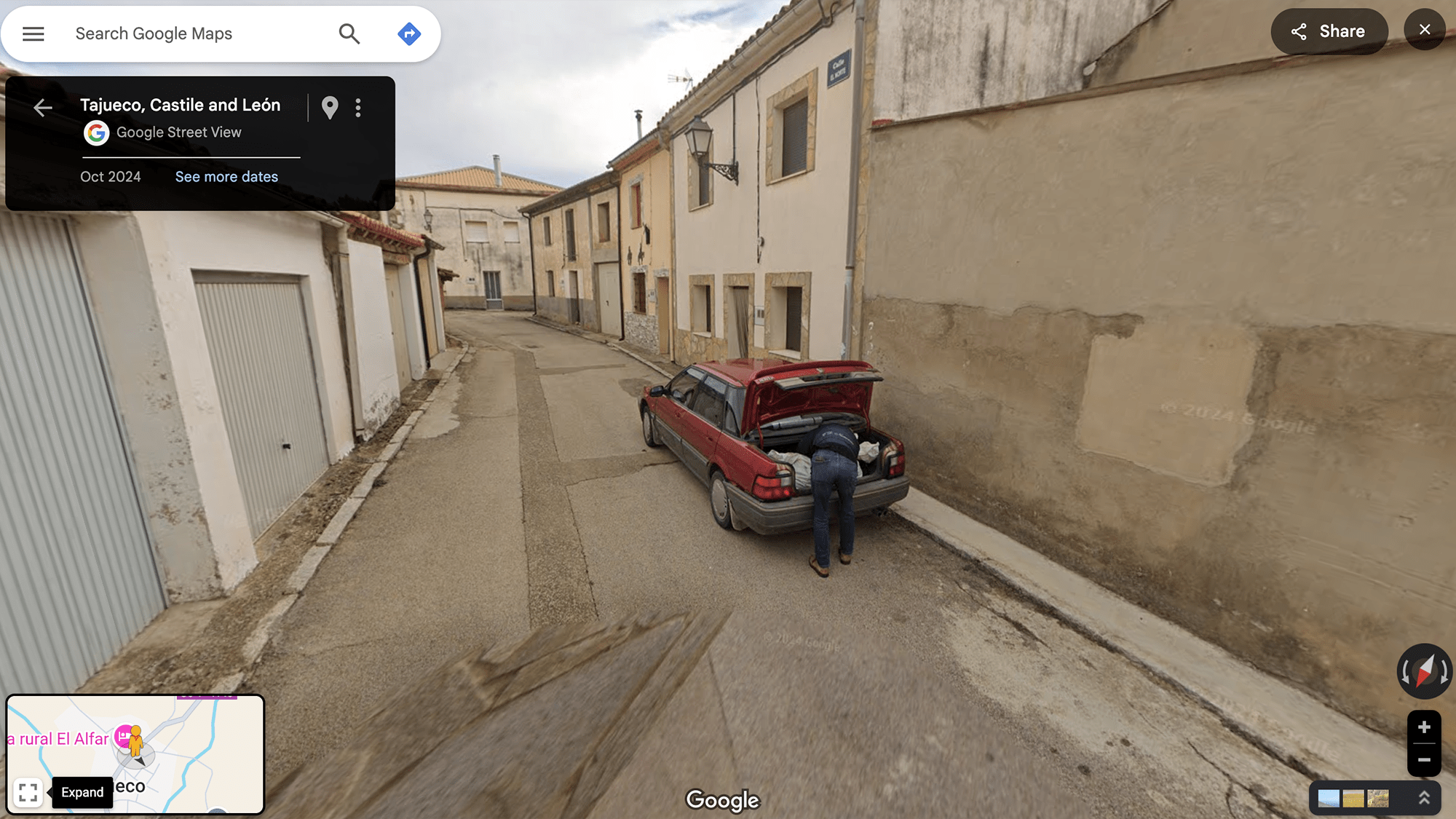You can run, but you can’t hide from Google’s vast mapping capabilities. Spanish authorities say an image routinely captured by one of the search giant’s Street View cameras in the province of Soria has helped them identify and arrest two people connected with a missing person. The image, shared by Spain’s National Police, shows a man wearing blue jeans and a sweatshirt shoving a large, lumpy white bag into the trunk of a car. Police say they have since found a severed torso they believe belonged to the missing person. The man in the image is one two alleged perpetrators tied to the man’s disappearance.
360-degree Google image helped confirm suspect’s identity
Sometime last year, according to the Spanish newspaper El País, a 33-year-old man from Cuba with the initials J.L.P.O. traveled to the Tajueco, a quiet town in Soria. The man had been in regular communication over the phone with his cousin back home but one day that line went silent. After a period of inactivity, the cousin, according to El País, says they started receiving messages again, but they sounded unfamiliar. They sounded suspicious. The cousin reportedly said he had met a woman and was preparing to move away from Soria. This story didn’t seem to add up which ultimately led the cousin to report J.L.P.O. missing.
An initial investigation by the National Police reportedly led them to two people in the province, a man and a woman. The police received authorization to search their homes and visually inspect their cars, where they say they found “elements relevant to the investigation.” At some point, police obtained an image captured by Google Street view in Tajueco showing a man shoving the large white bag into the trunk of a red car. A spokesperson for the National Police said the image was one of multiple pieces of evidence they used to ultimately bring charges and said the Street View image, on its own “was not decisive.”
Though law enforcement did not specify when exactly the image was captured, Google reportedly updates its Street View images every three years. Officials also did not specify whether they had obtained the image themselves using Google’s publicly searchable Street View or whether they had assistance from Google. Google didn’t respond to our request for comment but told The New York Times it could not comment on an ongoing investigation.
Police said they later found the remains of a human torso in an “advanced state of decomposition,” buried in a Soria cemetery. This video, posted to X by the National Police, reportedly shows officials excavating the areas.
🚩Detenidas dos personas presuntamente implicadas en la desaparición y muerte de un varón en #Soria
🚔Una de las pistas fueron unas imágenes que detectaron los investigadores en una aplicación de búsqueda de ubicaciones
👮Parte de los restos humanos han sido hallados… pic.twitter.com/5ZDFPbSul9
— Policía Nacional (@policia) December
18, 2024
Google’s global mapping power is valuable for law enforcement
This isn’t the first time law enforcement have turned to Google mapping tools to aid in investigations. Google Maps and Street View were previously used by Italian authorities in 2022 to track down a Sicilian man convicted of murder who had broken out of a prison in Rome two decades prior. In that case, investigators used Google Maps to look up images around a fruit store which they believe the alleged murderer owned. They then discovered an image captured by Google of what looked like their target standing in front of the store. Three years prior to that, authorities were reportedly able to find the remains of a Florida man who had been missing for 22 years by zooming in on a Google satellite image which revealed his car submerged in a lake. The man’s decomposing remains were reportedly found still strapped into the driver’s seat.
But Street View has also raised alarm bells from privacy and security activists. Multiple regulators from countries around the world have investigated the company regarding its data collection practices. In 2013, Google settled a lawsuit for $7 million and acknowledged it violated users’ privacy when its Street View cars reportedly sucked up passwords, emails, and WiFi data from areas it was mapping. Three years later, an 2016 Oklahoma man was charged after he allegedly attacked several Google Street view cameras he believed were tracking his movements. In a sense, the Google trucks were surveilling him. Well, him and just about everyone else. Google Earth reportedly covered more than 98% of the world’s population as of 2019.

